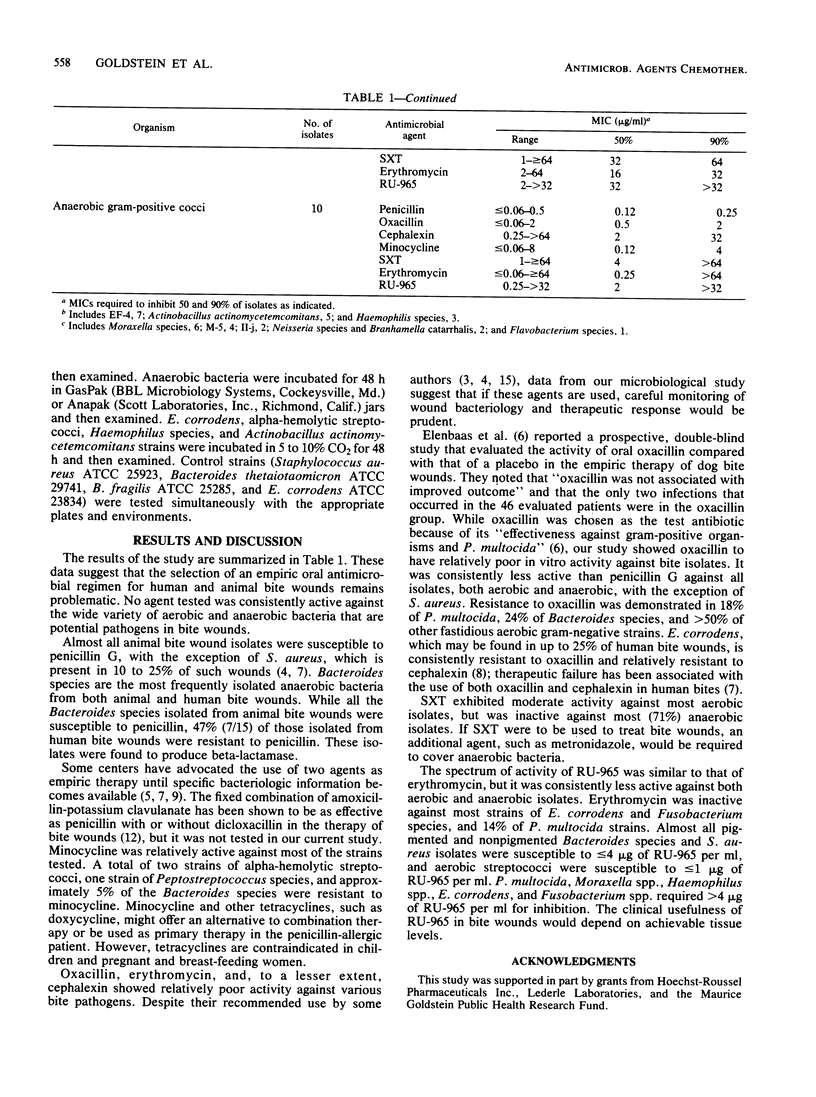Abstract
The susceptibility of 93 aerobic and 59 anaerobic bacteria isolated from human and animal bite wounds was determined by agar dilution. No agent tested (penicillin, oxacillin, cephalexin, sulfamethoxazole-trimethoprim, minocycline, erythromycin, and RU-965) was consistently active against all isolates. A total of 21% of the Bacteroides species, all isolated from human bites, were resistant to penicillin; 14 and 18% of the Pasteurella multocida isolates were resistant to erythromycin and oxacillin, respectively.
Full text
PDF



Selected References
These references are in PubMed. This may not be the complete list of references from this article.
- Butler T., Weaver R. E., Ramani T. K., Uyeda C. T., Bobo R. A., Ryu J. S., Kohler R. B. Unidentified gram-negative rod infection. A new disease of man. Ann Intern Med. 1977 Jan;86(1):1–5. doi: 10.7326/0003-4819-86-1-1. [DOI] [PubMed] [Google Scholar]
- Callaham M. L. Treatment of common dog bites: infection risk factors. JACEP. 1978 Mar;7(3):83–87. doi: 10.1016/s0361-1124(78)80063-x. [DOI] [PubMed] [Google Scholar]
- Callaham M. Prophylactic antibiotics in common dog bite wounds: a controlled study. Ann Emerg Med. 1980 Aug;9(8):410–414. doi: 10.1016/s0196-0644(80)80153-3. [DOI] [PubMed] [Google Scholar]
- Douglas L. G. Bite wounds. Am Fam Physician. 1975 Apr;11(4):93–99. [PubMed] [Google Scholar]
- Elenbaas R. M., McNabney W. K., Robinson W. A. Prophylactic oxacillin in dog bite wounds. Ann Emerg Med. 1982 May;11(5):248–251. doi: 10.1016/s0196-0644(82)80093-0. [DOI] [PubMed] [Google Scholar]
- Goldstein E. J., Barones M. F., Miller T. A. Eikenella corrodens in hand infections. J Hand Surg Am. 1983 Sep;8(5 Pt 1):563–567. doi: 10.1016/s0363-5023(83)80126-9. [DOI] [PubMed] [Google Scholar]
- Goldstein E. J., Citron D. M., Finegold S. M. Dog bite wounds and infection: a prospective clinical study. Ann Emerg Med. 1980 Oct;9(10):508–512. doi: 10.1016/s0196-0644(80)80188-0. [DOI] [PubMed] [Google Scholar]
- Goldstein E. J., Citron D. M., Finegold S. M. Role of anaerobic bacteria in bite-wound infections. Rev Infect Dis. 1984 Mar-Apr;6 (Suppl 1):S177–S183. doi: 10.1093/clinids/6.supplement_1.s177. [DOI] [PubMed] [Google Scholar]
- Goldstein E. J., Citron D. M. Susceptibility of Eikenella corrodens to penicillin, apalcillin, and twelve new cephalosporins. Antimicrob Agents Chemother. 1984 Dec;26(6):947–948. doi: 10.1128/aac.26.6.947. [DOI] [PMC free article] [PubMed] [Google Scholar]
- Goldstein E. J., Citron D. M., Wield B., Blachman U., Sutter V. L., Miller T. A., Finegold S. M. Bacteriology of human and animal bite wounds. J Clin Microbiol. 1978 Dec;8(6):667–672. doi: 10.1128/jcm.8.6.667-672.1978. [DOI] [PMC free article] [PubMed] [Google Scholar]
- Peeples E., Boswick J. A., Jr, Scott F. A. Wounds of the hand contaminated by human or animal saliva. J Trauma. 1980 May;20(5):383–389. [PubMed] [Google Scholar]
- Stevens D. L., Higbee J. W., Oberhofer T. R., Everett E. D. Antibiotic susceptibilities of human isolates of Pasteurella multocida. Antimicrob Agents Chemother. 1979 Sep;16(3):322–324. doi: 10.1128/aac.16.3.322. [DOI] [PMC free article] [PubMed] [Google Scholar]
- Weber D. J., Wolfson J. S., Swartz M. N., Hooper D. C. Pasteurella multocida infections. Report of 34 cases and review of the literature. Medicine (Baltimore) 1984 May;63(3):133–154. [PubMed] [Google Scholar]


